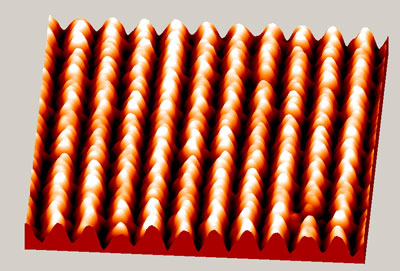| Oct 24, 2012 |
Obstinate electrons 'ignore' assumptions and follow another path
|
|
(Nanowerk News) It is possible to make gold wires so thin that there is not even enough room for electrons to pass one another. It’s as if they were driving down a one-lane motorway, this has a major impact on traffic flow. But exactly what path do the electrons take? Measurements made by researchers at the University of Twente’s MESA+ Institute for Nanotechnology supplied the answer. Surprisingly, it was found that the electrons do not move through the nanowires themselves, but through the “troughs” between them.
|
|
The researchers demonstrated this in a recent article published in the prestigious journal Nature Physics ("Origin of the Au/Ge (001) metallic state").
|
 |
| Atomic force microscopy image (17 nanometres by 15 nanometres) showing rows of nanowires on a germanium surface.
|
|
The nanowires, which have a cross-sectional area of no more than one square nanometre (a nanometre is one millionth of a millimetre), are attached to a substrate made of the semiconductor germanium. The virtually defect-free nanowires are spaced at intervals of just 1.6 nanometres. This forces electrons to adopt one-dimensional behaviour.
|
|
Parallel or perpendicular
|
|
In a recent paper in Nature Physics, German researchers stated that electrons show this behaviour in a direction parallel to the gold nanowires. Their research showed that the “motorway lanes” are located along the gold nanowire “ridges”. Japanese researchers responded by stating that the electrons actually move in a direction that is perpendicular to the alignment of the gold nanowires. Researchers from the Physics of Interfaces and Nanomaterials group, which is headed by Prof. Harold Zandvliet, decided to test these ideas, by creating a spatial image of the electrons’ conduction path. So who was right? The Germans were right, to the extent that the electrons do move parallel to the nanowires. However, charge transport takes place in the “troughs” between the nanowires, not along the nanowires themselves. As a result, the study sheds surprising new light on the behaviour of charge carriers at the atomic scale.
|

